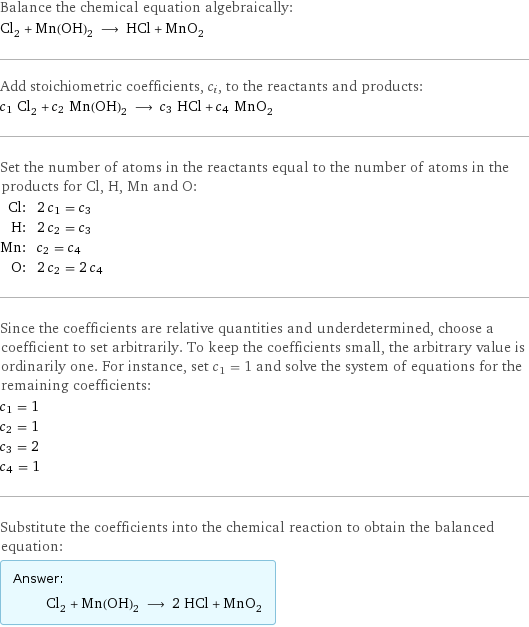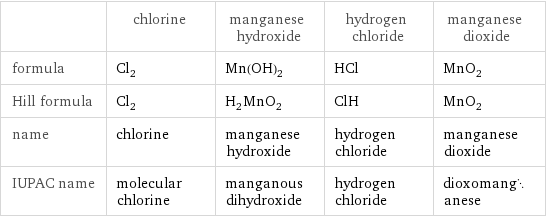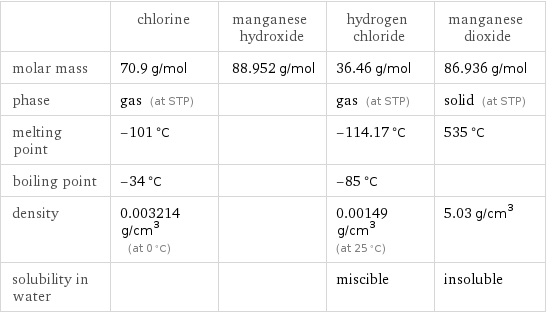Input interpretation

Cl_2 chlorine + Mn(OH)_2 manganese hydroxide ⟶ HCl hydrogen chloride + MnO_2 manganese dioxide
Balanced equation

Balance the chemical equation algebraically: Cl_2 + Mn(OH)_2 ⟶ HCl + MnO_2 Add stoichiometric coefficients, c_i, to the reactants and products: c_1 Cl_2 + c_2 Mn(OH)_2 ⟶ c_3 HCl + c_4 MnO_2 Set the number of atoms in the reactants equal to the number of atoms in the products for Cl, H, Mn and O: Cl: | 2 c_1 = c_3 H: | 2 c_2 = c_3 Mn: | c_2 = c_4 O: | 2 c_2 = 2 c_4 Since the coefficients are relative quantities and underdetermined, choose a coefficient to set arbitrarily. To keep the coefficients small, the arbitrary value is ordinarily one. For instance, set c_1 = 1 and solve the system of equations for the remaining coefficients: c_1 = 1 c_2 = 1 c_3 = 2 c_4 = 1 Substitute the coefficients into the chemical reaction to obtain the balanced equation: Answer: | | Cl_2 + Mn(OH)_2 ⟶ 2 HCl + MnO_2
Structures

+ ⟶ +
Names

chlorine + manganese hydroxide ⟶ hydrogen chloride + manganese dioxide
Equilibrium constant
![Construct the equilibrium constant, K, expression for: Cl_2 + Mn(OH)_2 ⟶ HCl + MnO_2 Plan: • Balance the chemical equation. • Determine the stoichiometric numbers. • Assemble the activity expression for each chemical species. • Use the activity expressions to build the equilibrium constant expression. Write the balanced chemical equation: Cl_2 + Mn(OH)_2 ⟶ 2 HCl + MnO_2 Assign stoichiometric numbers, ν_i, using the stoichiometric coefficients, c_i, from the balanced chemical equation in the following manner: ν_i = -c_i for reactants and ν_i = c_i for products: chemical species | c_i | ν_i Cl_2 | 1 | -1 Mn(OH)_2 | 1 | -1 HCl | 2 | 2 MnO_2 | 1 | 1 Assemble the activity expressions accounting for the state of matter and ν_i: chemical species | c_i | ν_i | activity expression Cl_2 | 1 | -1 | ([Cl2])^(-1) Mn(OH)_2 | 1 | -1 | ([Mn(OH)2])^(-1) HCl | 2 | 2 | ([HCl])^2 MnO_2 | 1 | 1 | [MnO2] The equilibrium constant symbol in the concentration basis is: K_c Mulitply the activity expressions to arrive at the K_c expression: Answer: | | K_c = ([Cl2])^(-1) ([Mn(OH)2])^(-1) ([HCl])^2 [MnO2] = (([HCl])^2 [MnO2])/([Cl2] [Mn(OH)2])](../image_source/16434d716c84891c92f1ba24f804e3f0.png)
Construct the equilibrium constant, K, expression for: Cl_2 + Mn(OH)_2 ⟶ HCl + MnO_2 Plan: • Balance the chemical equation. • Determine the stoichiometric numbers. • Assemble the activity expression for each chemical species. • Use the activity expressions to build the equilibrium constant expression. Write the balanced chemical equation: Cl_2 + Mn(OH)_2 ⟶ 2 HCl + MnO_2 Assign stoichiometric numbers, ν_i, using the stoichiometric coefficients, c_i, from the balanced chemical equation in the following manner: ν_i = -c_i for reactants and ν_i = c_i for products: chemical species | c_i | ν_i Cl_2 | 1 | -1 Mn(OH)_2 | 1 | -1 HCl | 2 | 2 MnO_2 | 1 | 1 Assemble the activity expressions accounting for the state of matter and ν_i: chemical species | c_i | ν_i | activity expression Cl_2 | 1 | -1 | ([Cl2])^(-1) Mn(OH)_2 | 1 | -1 | ([Mn(OH)2])^(-1) HCl | 2 | 2 | ([HCl])^2 MnO_2 | 1 | 1 | [MnO2] The equilibrium constant symbol in the concentration basis is: K_c Mulitply the activity expressions to arrive at the K_c expression: Answer: | | K_c = ([Cl2])^(-1) ([Mn(OH)2])^(-1) ([HCl])^2 [MnO2] = (([HCl])^2 [MnO2])/([Cl2] [Mn(OH)2])
Rate of reaction
![Construct the rate of reaction expression for: Cl_2 + Mn(OH)_2 ⟶ HCl + MnO_2 Plan: • Balance the chemical equation. • Determine the stoichiometric numbers. • Assemble the rate term for each chemical species. • Write the rate of reaction expression. Write the balanced chemical equation: Cl_2 + Mn(OH)_2 ⟶ 2 HCl + MnO_2 Assign stoichiometric numbers, ν_i, using the stoichiometric coefficients, c_i, from the balanced chemical equation in the following manner: ν_i = -c_i for reactants and ν_i = c_i for products: chemical species | c_i | ν_i Cl_2 | 1 | -1 Mn(OH)_2 | 1 | -1 HCl | 2 | 2 MnO_2 | 1 | 1 The rate term for each chemical species, B_i, is 1/ν_i(Δ[B_i])/(Δt) where [B_i] is the amount concentration and t is time: chemical species | c_i | ν_i | rate term Cl_2 | 1 | -1 | -(Δ[Cl2])/(Δt) Mn(OH)_2 | 1 | -1 | -(Δ[Mn(OH)2])/(Δt) HCl | 2 | 2 | 1/2 (Δ[HCl])/(Δt) MnO_2 | 1 | 1 | (Δ[MnO2])/(Δt) (for infinitesimal rate of change, replace Δ with d) Set the rate terms equal to each other to arrive at the rate expression: Answer: | | rate = -(Δ[Cl2])/(Δt) = -(Δ[Mn(OH)2])/(Δt) = 1/2 (Δ[HCl])/(Δt) = (Δ[MnO2])/(Δt) (assuming constant volume and no accumulation of intermediates or side products)](../image_source/46e65dbf9902bd81cc5694ec56f425aa.png)
Construct the rate of reaction expression for: Cl_2 + Mn(OH)_2 ⟶ HCl + MnO_2 Plan: • Balance the chemical equation. • Determine the stoichiometric numbers. • Assemble the rate term for each chemical species. • Write the rate of reaction expression. Write the balanced chemical equation: Cl_2 + Mn(OH)_2 ⟶ 2 HCl + MnO_2 Assign stoichiometric numbers, ν_i, using the stoichiometric coefficients, c_i, from the balanced chemical equation in the following manner: ν_i = -c_i for reactants and ν_i = c_i for products: chemical species | c_i | ν_i Cl_2 | 1 | -1 Mn(OH)_2 | 1 | -1 HCl | 2 | 2 MnO_2 | 1 | 1 The rate term for each chemical species, B_i, is 1/ν_i(Δ[B_i])/(Δt) where [B_i] is the amount concentration and t is time: chemical species | c_i | ν_i | rate term Cl_2 | 1 | -1 | -(Δ[Cl2])/(Δt) Mn(OH)_2 | 1 | -1 | -(Δ[Mn(OH)2])/(Δt) HCl | 2 | 2 | 1/2 (Δ[HCl])/(Δt) MnO_2 | 1 | 1 | (Δ[MnO2])/(Δt) (for infinitesimal rate of change, replace Δ with d) Set the rate terms equal to each other to arrive at the rate expression: Answer: | | rate = -(Δ[Cl2])/(Δt) = -(Δ[Mn(OH)2])/(Δt) = 1/2 (Δ[HCl])/(Δt) = (Δ[MnO2])/(Δt) (assuming constant volume and no accumulation of intermediates or side products)
Chemical names and formulas

| chlorine | manganese hydroxide | hydrogen chloride | manganese dioxide formula | Cl_2 | Mn(OH)_2 | HCl | MnO_2 Hill formula | Cl_2 | H_2MnO_2 | ClH | MnO_2 name | chlorine | manganese hydroxide | hydrogen chloride | manganese dioxide IUPAC name | molecular chlorine | manganous dihydroxide | hydrogen chloride | dioxomanganese
Substance properties

| chlorine | manganese hydroxide | hydrogen chloride | manganese dioxide molar mass | 70.9 g/mol | 88.952 g/mol | 36.46 g/mol | 86.936 g/mol phase | gas (at STP) | | gas (at STP) | solid (at STP) melting point | -101 °C | | -114.17 °C | 535 °C boiling point | -34 °C | | -85 °C | density | 0.003214 g/cm^3 (at 0 °C) | | 0.00149 g/cm^3 (at 25 °C) | 5.03 g/cm^3 solubility in water | | | miscible | insoluble
Units
